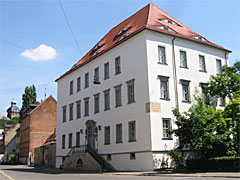
|
||
|
·AQUARIUM·
Novalis im Netz
|
||
|
|
||
|
||
|
||
|
||
|
|
Friedrich von Hardenberg (1772–1801), known as NOVALIS, is the most important representative of the early romantic period in Germany. He died too early to implement his extensive plans and to summarise his manifold thoughts and research results. His works remained fragmentary. As a philosopher, mathematician and chemist he left an important archive for his period. The early death of his first fiancée, Sophie von Kühn, moved the poet to a mystic schwärmerei for death and night. In the "Hymnen an die Nacht" he eulogises his dead love and thus makes her immortal. Some of his "Geistliche Lieder" were included in the hymnals of protestant churches. His Bildungsroman "Heinrich von Ofterdingen" which contains the myth of the blue flower remained unfinished, as did his second novel "Die Lehrlinge zu Sais."
The visitors should not miss the small baroque garden pavilion near the house and, in the town park, the bust of Friedrich von Hardenberg which was erected there on the occasion of the centenary of his death. In spite of his delicate health Friedrich received a varied but strongly religious education, first from his mother, later from governesses and tutors. In 1790 he extended his knowledge of Latin and Greek at the grammar school in Eisleben and began to study law and philosophy at the University of Jena. Here he made the acquaintance of Friedrich Schiller. At the end of 1791 he continued his studies in Leipzig and got to know Friedrich Schlegel. In June 1794 he passed the first state examination in law at the University of Wittenberg. At the beginning of 1796 he returned to Weißenfels and played an extensive part in the supervision of the saline refineries in Artern, Bad Kösen and Bad Dürrenberg. In 1798 in order to extend his knowledge of mining he began to study at the mining academy in Freiberg in Saxony. In addition to publishing his poetic works he pays visits to Schlegel, Schelling, Goethe and Jean Paul. In December of that year he becomes betrothed to Julie von Charpentier (1776–1811), the daughter of a mining director. In May 1799 back in Weißenfels he completes an immense programme of work both for the saline authorities and in fulfilment of his philosophical and poetic ambitions. He is appointed to the office of Amtshauptmann for the Thuringian region of Saxony. As a result of this stress his strength was soon exhausted. Tuberculosis of the lung contributed to the deterioration of his state of health. In the presence of his brother, Karl, and his friend Friedrich Schlegel, a haemorrhage puts an early end to his life on 25th March 1801. Opening hours
Tuesday to Friday: 10 a.m. – 5 p.m.
Novalis-Haus, Klosterstraße 24, 06667 Weißenfels, Germany For more information on Carlyle and Novalis have a look at the related site within the Victorian Web. |

